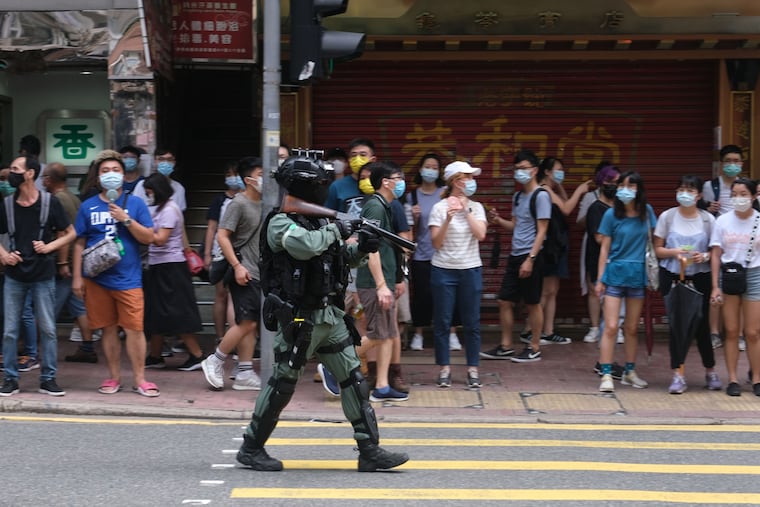By sending feds to U.S. cities for political gain, Trump follows autocrats’ playbook | Trudy Rubin
Trump mimics the tactics used by Syrian, Egyptian, Russian and Chinese autocrats by stoking violence and fear so he can play strongman savior.

President Donald Trump is taking a page straight out of the strongman’s playbook by sending federal forces into Democrat-led cities, where governors and mayors neither need nor want them.
From Syria, to Egypt, to Russia and Hong Kong, I have seen this playbook in operation. The strategy goes like this: Despots stoke violence and civil strife to scare their people into supporting leaders who would “protect” them.
If protests are peaceful, autocrats reject compromise and provoke chaos, as an excuse to unleash their own violence. If protests draw on, and the public grows weary, autocrats move in as saviors, threatening force against any remaining resisters.
» READ MORE: White House may be turning VOA into Trump Radio Network I Trudy Rubin
This was the strategy used to crush civic protests in the Middle East, Russia, and Hong Kong over the past decade and up to the present.
Yet I never expected to see Trump try to enact this playbook here.
The Trump version already exceeds a “wag the dog” effort to distract from his abject failure with COVID-19. And it differs from “law and order” campaigns we have seen in this country before.
Yes, his strategy is directly linked to the release of dark Trump campaign ads that falsely portray U.S. cities as overrun by mob violence.
But Trump has gone beyond photo-op fascism. He is cribbing from Authoritarianism 101 with his legally dubious dispatch of federal law enforcement agents to cities whose mayors don’t want them. Far from calming the streets, their presence has revived waning demonstrations in Portland, Ore., and may itself provoke violence.
As Oregon’s Democratic Sen. Ron Wyden warned, “If the line is not drawn in the sand right now, Americans may be staring down the barrel of martial law in the middle of a presidential election.”
With the president’s announcement that he’ll send more uninvited agents into multiple cities “to fight crime,” the legal pretext becomes ever more specious. The feds begin to look more like Trump’s personal militia.
So it’s none too soon to look at how other authoritarians have used the playbook from which Trump is drawing his moves.
I will never forget interviewing Syrian writer Samar Yazbek, who risked her life in 2011 to document how peaceful Syrian protests turned into armed rebellion.
An educated, secular woman with flowing blond hair, she traveled in disguise to watch as unarmed demonstrators were attacked by regime snipers and militias. “[Syrian President Bashar] Al-Assad sought to frighten minorities and moderate Sunnis into believing they must support him,” she told me. Regime thugs, known as shabiha, spread rumors among Assad’s Alawite (a Shiite offshoot) followers that Sunnis were coming to rape and kill them.
The goal, Yazbek said, was “to goad one Syrian sect to fight the other.”
I heard the same from Sunni businessmen, small merchants, and farmers, whom I interviewed along the Syrian-Turkish border in 2011 and 2012. They said they didn’t want a civil war, but sought governmental reforms that would curb the corruption of the Assad family. They wanted a voice in the government.
But Assad rejected moderates’ demands and was willing to destroy his country in order to keep power. He used personal militias to attack Sunnis and goad them into armed resistance. He persuaded a majority of Alawites, Christians, and wealthy Sunnis that they needed his dictatorship to stay safe.
Other despots have worked from a similar playbook, rallying weary publics to reject protesters when demonstrations became endless and spawned violence. Egyptian Gen. Abdel Fattah El-Sisi waited for Egyptians to tire of post-revolutionary upheaval in Cairo and for demonstrations to deteriorate into violence on the margins. Then he used his intelligence services – a form of personal militia – to conduct a coup that won public support.
As head of Russia’s intelligence services, Vladimir Putin used a series of apartment bombings in Russia – which many Russia experts believe were set by his agents — to gin up a fear of terrorism and Chechens that he rode to the Russian presidency.
Beijing, too, used a small minority of violent demonstrators (and the cover of COVID-19) as justification for cracking down on Hong Kong’s peaceful protesters, whom it refused to negotiate with.
However, the sad outcomes in Egypt and Hong Kong also offer a lesson in caution to U.S. protesters for social justice. The leaders of Cairo’s Tahrir Square revolt, many of whom I interviewed, knew how to rally mass protests for change. But they failed dismally to translate those skills into practical politics, missing their chance to elect a moderate reformer for president. They wound up with a new autocrat.
» READ MORE: Beijing's crackdown on Hong Kong is dangerous for the world I Trudy Rubin
In Hong Kong, protests may have gone on too long, as the pro-democracy movement failed to curb spurts of violence and underestimated Beijing’s desire for total power.
Back in the USA, Trump’s use of the autocrats’ playbook is an unmistakable warning: Those who believe in the rule of law must all work together, submerging differences, to stop this president from further threatening our democracy. As Chicago Mayor Lori Lightfoot put it, fighting violence is fine, “but we do not welcome dictatorship.”
Listen up, President Trump.